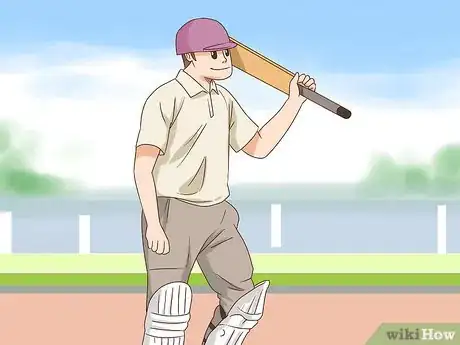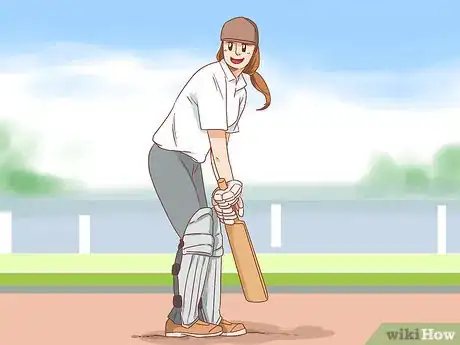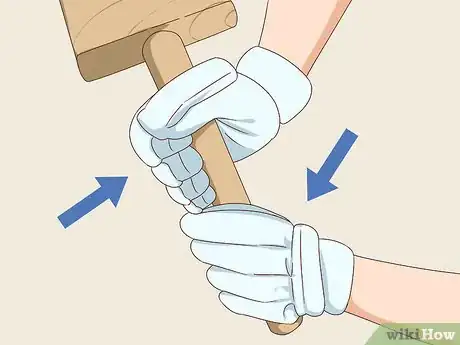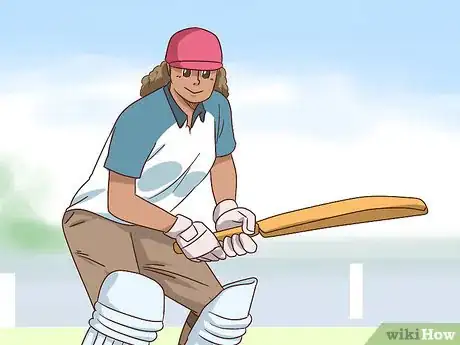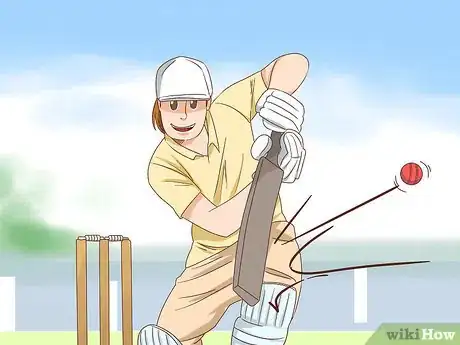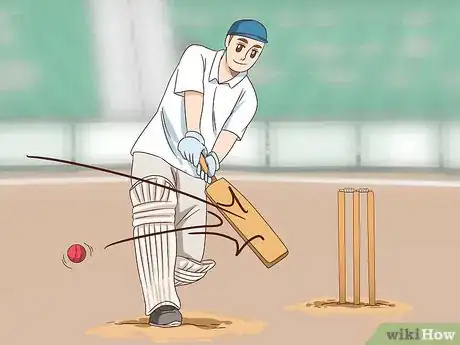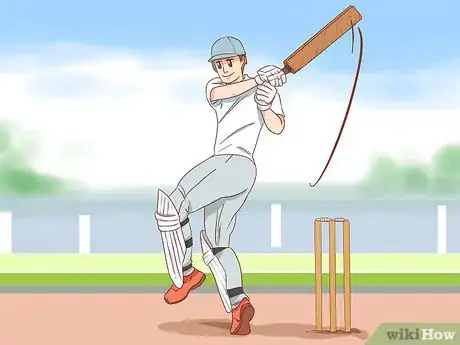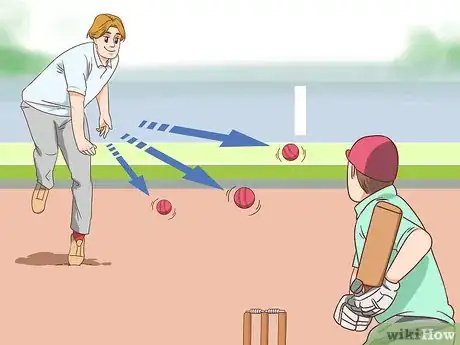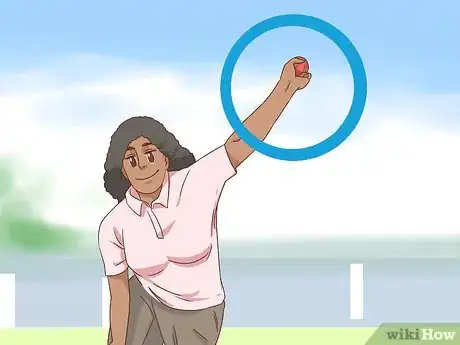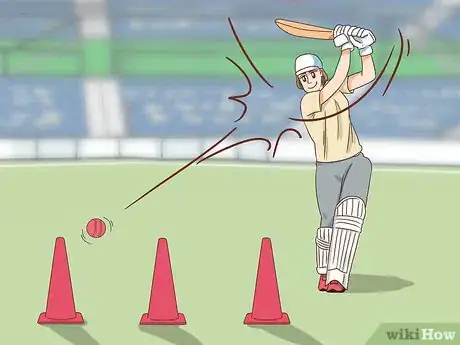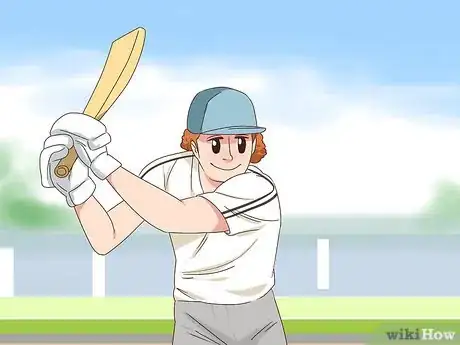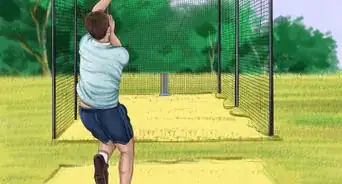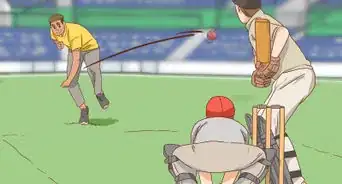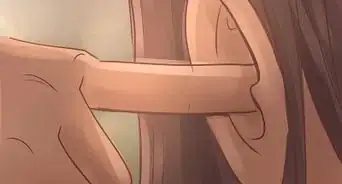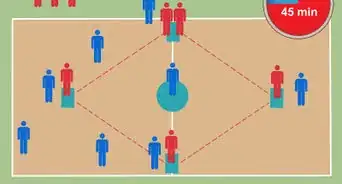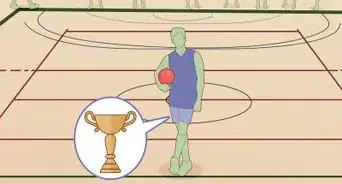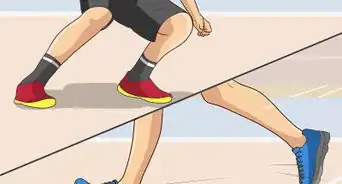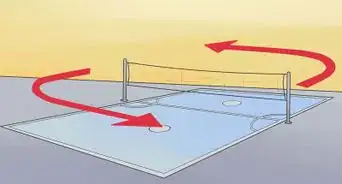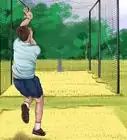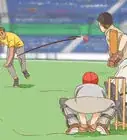This article was co-authored by Rishabh Mehan. Rishabhn Mehan is a Cricket Systems Operator in the United Kingdom. He has been coaching cricket in London since 2016, when he received his Level 2 Certificate in Coaching Young People and Adults Cricket (QCF).
There are 14 references cited in this article, which can be found at the bottom of the page.
wikiHow marks an article as reader-approved once it receives enough positive feedback. In this case, 91% of readers who voted found the article helpful, earning it our reader-approved status.
This article has been viewed 251,689 times.
Facing a fast bowler is intimidating, but the first step to success to convey that you’re in charge. Stay confident, and don’t let the bowler think that you’re afraid. Relax and keep your hands soft, as you’ll need to make quick adjustments to make strategic shots. You might not be able to shoot long drives off of a fast bowler, so focus on defending the stumps and hitting the gaps. Relying on your instincts is key, so sharpen them by practicing your batting technique as much as possible.
Steps
Getting Set in Your Crease
-
1Show the bowler that you’re not afraid of speed. Before you approach, maintain a positive mindset and tell yourself that you can handle high speeds. Walk up with confidence and look toward the bowler to give the impression that you’re in charge.[1]
- A strong mental game is the first step of batting. Set yourself up for success by getting rest and having a good meal before the match.
-
2Keep your stance comfortable and relaxed. Stand in front of the wickets with your knees slightly bent, your feet shoulder-width apart, and your non-dominant shoulder facing the bowler. Turn your head toward the bowler, bend slightly forward from your hips, and keep your torso straight.[2]
- Put your weight on the balls of your feet so you can quickly react to the ball. Keep your shoulders straight, and don’t let them drop as you swing.
- For a fast bowler, you might want to open your stance a bit by turning your body slightly toward the bowler. This can give you a clearer view of the ball.[3]
Advertisement -
3Hold the bat with a soft grip. Grip the bat with your non-dominant hand positioned near the top of the handle. Your dominant hand should be closer to the paddle, and your hands should be fairly close together.[4]
- Don’t keep your grip strong or rigid, as if you wanted to launch the ball with power. Keep your hands soft and be ready to open them up to make a quick defensive swing.
- When facing a tough, fast bowler, hitting the boundary is less of a priority than making defensive contact and hitting the gaps.[5]
-
4Keep your head still and watch the ball at all times. Don’t be afraid of the ball. If you keep your eyes on the ball, anticipate its trajectory, and stay ready to react, you're less likely to get hit. Watch the line and length of the bowler’s delivery, and your instincts will help you decide which shot to play.[6]
- It takes practice but, with experience, you’ll learn which deliveries you can make strong contact with, which require a defensive swing, and which aren’t playable.
Making Your Shot
-
1Work on triggering to stay in motion before the pitch. If you stay stationary in the crease, you won’t have as much time to react against a fast bowler. Upon their delivery, trigger by stepping back slightly so you can quickly position yourself for the right shot. As you step back, be sure to keep 75% of your weight on your front foot so your back foot doesn’t get stuck.[7]
- If your transfer too much weight to your back foot, it’ll take longer to make a shot with a forward step. With more weight on your front foot, you’ll be able to quickly forward or back, depending on the shot you need to make.
- Remember to keep your weight on the balls of your feet to quicken your footwork.
-
2Defend the stumps if the bowler is aiming low and fast. If you’re facing a fast bowler, odds they’re aiming to put down the wicket. Step forward with your front leg, and make a straight shot by swinging the bat upward with the full face of the bat facing the ball.[8]
- Remember to focus on making contact instead of trying to drive the ball.
-
3Swing the bat to the side if the ball bounces short. If the ball bounces early, step backward with your back foot and prepare to make a high defensive shot. Instead of swinging straight, swing the bat to the side to drive the ball toward a gap.[9]
- This swing is called a pull shot, and it’s used to drive the ball to the leg side.[10]
- With a fast bowler, you’re more likely to score runs by making strategic shots toward gaps instead of driving it to the boundary.
-
4Look for opportunities for back foot drives. While you’ll likely need to make lots of defensive shots against a fast bowler, stay ready to react to a shot that bounces at a favorable length at middle or off stump. When the opportunity for a back-foot drive arises, keep most of your weight forward, draw your front foot back, and align the bat with the ball’s trajectory.[11]
- Guide the shot with your top hand, and power it by punching with your bottom hand. Follow through with the bat and your hands in a high position in line with the shot.
Improving Your Reactions
-
1Have a partner hit tennis balls to you as you bat. Instead of pitching like an ordinary bowler, your partner can hit tennis balls with a racket toward you to simulate high-speed pitches. Work on keeping your eye on the ball, tracing its trajectory from the racket, and making contact with the target.[12]
- Tennis balls are softer than cricket balls. Practicing with them can help you adapt to high-speed pitches if you’re afraid to get hurt by a fast, hard cricket ball.
-
2Work on judging the ball’s line of delivery. Set up the stumps and have a partner bowl pitches at a specific stump. Stand in your crease and call out which stump the ball will target. With each pitch, check with your partner to make sure you’re correctly judging the ball’s trajectory.[13]
- Instead of their ordinary labels “off,” “middle,” and “leg,” you can call out “1,” “2,” or “3.”
- To improve your judgment of pitches outside the wicket, place another set of stumps next to the standard posts on the opposite side that you stand to bat. Label this set “4,” “5,” and “6.”
- If you’re consistently getting stumped or bowled, work on honing your ability to predict the ball’s trajectory. This drill can help you decide whether you need to attack, lay off, or defend the stumps.
-
3Watch your partner’s grip as they bowl. Practice anticipating the ball’s spin and trajectory by calling out the grip after your partner bowls. For instance, if you see 1 finger, say “1,” then check your accuracy with your partner.[14]
- If you see 2 fingers and anticipate a tricky spin, you’ll know to lay off or get out of the way.
-
4Set up target cones to practice making your shots. Set up pairs of cones ahead and to the left and right. Have your partner throw to you, and practice opening and closing your hands to adjust the bat’s face. Adjust your swing and the angle of the bat to aim the ball toward the gaps between the cones.[15]
- Step back, turn up your front shoulder, swing inside-out to square your swing and send the ball away from you.
- Close up and swing from outside-in to pull your swing.
-
5Practice batting with golf or squash balls. Have your partner bowl smaller balls, such as golf or squash balls, to improve your hand-eye coordination. Focus on watching the ball leave the bowler’s hand and making contact with the smaller target.[16]
- The smaller ball can simulate the difficulty of batting against a fast bowler. If possible, find a skinnier cricket bat to increase the level of difficulty.
Community Q&A
-
QuestionWhy I am bowled out when playing defensive shots?
 Community AnswerYou might not be defending properly. Always make sure the ball is in your eye-line when the ball meets contact with your bat. Make sure you are looking at the ball. Also, try leaving the balls which are wide of off stump and good length.
Community AnswerYou might not be defending properly. Always make sure the ball is in your eye-line when the ball meets contact with your bat. Make sure you are looking at the ball. Also, try leaving the balls which are wide of off stump and good length. -
QuestionHow can I settle my mind before going to bat?
 Community AnswerJust think about how well you can perform. Recall all the good things you have done in the past and tell yourself that you can do them again.
Community AnswerJust think about how well you can perform. Recall all the good things you have done in the past and tell yourself that you can do them again. -
QuestionWhat should I do if the ball from a fast bowler is too fast for me to see?
 Community AnswerStart practicing with a fast bowler, and it will help you to become comfortable with the bowling speed. Or keep your head steady and keep watching the ball from the releasing point of the bowler's hand until the ball comes in contact with the bat.
Community AnswerStart practicing with a fast bowler, and it will help you to become comfortable with the bowling speed. Or keep your head steady and keep watching the ball from the releasing point of the bowler's hand until the ball comes in contact with the bat.
Warnings
- While you should work on your confidence, be aware that getting hit by a fast bowler can hurt. Wear proper gear, including well-fitting pads, gloves, and a helmet.⧼thumbs_response⧽
References
- ↑ http://news.bbc.co.uk/sport2/hi/cricket/get_involved/4319406.stm
- ↑ https://www.youtube.com/watch?v=wZjCQs4O1q4&feature=youtu.be&t=38
- ↑ http://news.bbc.co.uk/sport1/hi/cricket/skills/4173030.stm
- ↑ http://news.bbc.co.uk/sport2/hi/cricket/skills/4173594.stm
- ↑ https://www.youtube.com/watch?v=hGz0o9uecak&feature=youtu.be&t=84
- ↑ http://news.bbc.co.uk/sport2/hi/cricket/get_involved/4319406.stm
- ↑ https://www.youtube.com/watch?v=YmF9kXM-pLs&feature=youtu.be&t=98
- ↑ http://news.bbc.co.uk/sport2/hi/cricket/skills/4177934.stm
- ↑ https://www.youtube.com/watch?v=F6OUlv6O24A&feature=youtu.be&t=101
- ↑ http://news.bbc.co.uk/sport2/hi/cricket/skills/4177934.stm
- ↑ http://news.bbc.co.uk/sport2/hi/cricket/skills/4174184.stm
- ↑ https://www.youtube.com/watch?v=Q0yBYOytE-w&feature=youtu.be&t=31
- ↑ https://www.youtube.com/watch?v=jBuENKcep8o&feature=youtu.be&t=19
- ↑ https://www.youtube.com/watch?v=iohtmGgSiAc&feature=youtu.be&t=15
- ↑ https://www.youtube.com/watch?v=hGz0o9uecak&feature=youtu.be&t=145
- ↑ https://www.youtube.com/watch?v=757BPhBbAMY&feature=youtu.be&t=15
About This Article
To bat against fast bowlers, position yourself in a comfortable batting stance and hold the bat with both hands using a light grip. Next, keep your head still and your eyes on the ball so you can anticipate the ball's trajectory. Then, after the bowler pitches the ball, trigger by stepping back slightly so you can quickly position yourself for the right shot. Be sure to keep 75% of your weight on your front foot so you can quickly move forward or back, depending on the shot you need to make! For tips on handling different kinds of fast pitches, read on!
